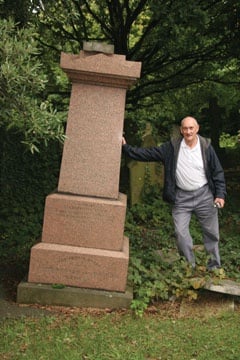David Francis is a hands-on mason who has specialised for many years on the memorial side of the stone industry. He was Technical Advisor to the National Association of Memorial Masons, writing manuals and City & Guilds Qualifications. If you have an issue regarding any aspect of memorial masonry, David is happy to help. Send your questions or comments to David at nss@qmj.co.uk
I was really saddened to hear about a young boy being killed in a cemetery in Glasgow (see NSS June 2015).
Having spent quite a lot of time in the past 15 years giving talks and training sessions in cemeteries, especially on the safety of memorials, I have spent a lot of time thinking about safety and helping others to think about it as well.
When I was training people I always emphasised that lawn memorials are not the most dangerous. It is the larger, older ones that most need to be assessed and yet least often are.
Children seldom climb on lawn memorials, but prefer to go for the larger, more challenging monuments to climb – and the bigger the better.
When cemetery authorities decided to tighten up on health & safety they largely concentrated on testing and toppling and staking lawn memorials, leaving the larger, older monuments alone.
It is not difficult to assess the safety of a large monument. It just needs someone with a little understanding of memorials who can also anticipate what children can get up to.
Apparently, in the latest case, the lads got through a hole in the fence. This hole should have been noticed by the cemetery staff, or even a memorial mason, and identified as a possible problem.
I assisted the Health & Safety Executive with the Ministry of Justice document 'Managing the Safety of Burial Ground Memorials', which expects cemeteries to take a responsible view of memorials. The Ministry of Justice advice is a good, well thought out piece of work that needs to be taken seriously. Where a memorial does pose a danger it should be made secure.
As masons, we do understand the vulnerability of monuments and should tell the authorities about any problems we see.
A single accident in a cemetery makes headlines in the newspapers – often being given more coverage than accidents in other locations, for some reason. The Health & Safety Executive says if you see a hazard, either fix it or report it to someone who can.
It is not just the responsibility of cemetery authorities to avoid accidents. There should be some sort of education going into schools and making parents who live near a burial ground or church yard aware of the hazards that are nearby.
After World War II, Victorian monuments all over the country were neglected and allowed to decay.
Cemetery maintenance regimes neglected some of the older areas and brambles grew, which protected them. But now cemeteries are being recognised as important public areas and are being cleaned up and maintained. I have been contracted to carry out a lot of such work.
It is time to be more responsible and worry about the condition and stability of these monuments.
It has been a while since we have had a major incident as bad as the one in Scotland, so maybe we have become a bit complacent. The Glasgow tragedy might remind us all of the dangers of heavy stones falling, especially as they age and weather.

